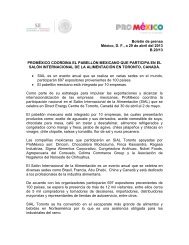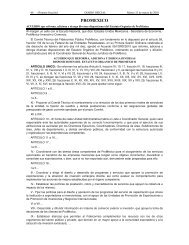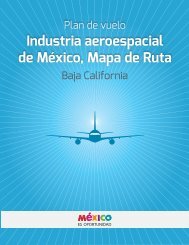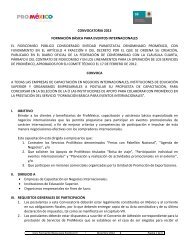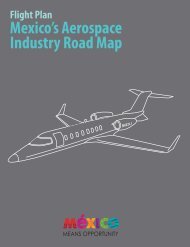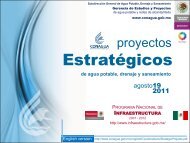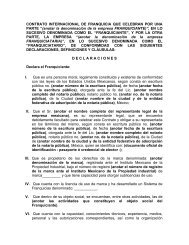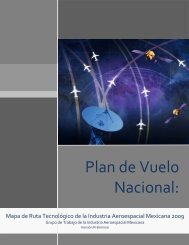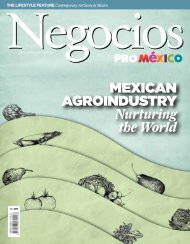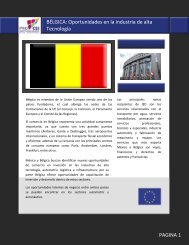MINING IN MEXICO S - ProMéxico
MINING IN MEXICO S - ProMéxico
MINING IN MEXICO S - ProMéxico
You also want an ePaper? Increase the reach of your titles
YUMPU automatically turns print PDFs into web optimized ePapers that Google loves.
22 Negocios photo courtesy of industrias peñoles<br />
2009. Of the total invested capital, 70% came<br />
from national companies with foreign capital.<br />
In December 2009, 692 exploration projects<br />
were registered in Mexico. Of this total figure,<br />
64% were gold and silver related projects,<br />
18% polymetallic projects (copper, zinc, silver<br />
and lead), 13% copper related projects and the<br />
remainder was spread out between several<br />
mineral exploration projects.<br />
Also, the Mexican mining sector posted<br />
a solid trade surplus. As of June 2009, its<br />
exports totaled almost 4 billion usd and its<br />
imports around 2 billion usd.<br />
In terms of employment, at the end of 2009<br />
Mexico’s mining industry employed 270,000<br />
workers. Mining was one of the first Mexican<br />
industrial sectors to show signs of recovery<br />
after the international downturn, generating<br />
4,613 new jobs since August 2009.<br />
Mining in Mexico has seen a year-on-year<br />
increase since 2006, at an average annual<br />
growth rate of 4.8% from 2006 to 2008. The<br />
sector registered an accumulated growth of<br />
23.4% up until September 2009.<br />
Supporting Investment<br />
Mexico was therefore able to remain as a leading<br />
investment destination in 2009 and one of<br />
strongest potentials for mining in the world.<br />
Analysis by prestigious international<br />
firms ranked Mexico in first place for exploration<br />
in Latin America and fourth in<br />
the world. The Behre Dolbear report, published<br />
in 2010, placed Mexico as the world’s<br />
fourth-best investment destination for mining<br />
among a 25-country-list and in first place<br />
regarding the fiscal regime.<br />
To assist investors, the Mexican Geological<br />
Survey has not only improved Internet<br />
access to its geological maps, as well as to<br />
inventories of minerals in the states and geochemical<br />
and geophysical research, but also<br />
the Ministry of Economy provides a follow<br />
up right from the promotion phase until providing<br />
accompaniment during the extraction<br />
or exploration phase, even afterwards,<br />
to review its performance and a successful<br />
conclusion.<br />
The government also provides all information<br />
on providers in the sector, on land<br />
ownership and the licenses and requirements<br />
for handling concessions, to guarantee<br />
legal certainty.<br />
The Ministry of Economy’s Mining Promotion<br />
Trust (FIFOMI) is another key player.<br />
In 2009 it helped capitalize micro, small and<br />
medium-sized mining companies as well as<br />
the sector’s production chain with loans worth<br />
510 million usd, 20% higher than in 2008, in<br />
addition to offering training and technical assistance<br />
to more than 8,000 companies.<br />
The government is particularly interested<br />
in reactivating those mining districts that<br />
are regions with high potential. Exploration<br />
schemes are taking place in those areas and<br />
sixteen districts are expected to be reactivated<br />
between 2009 and 2012.<br />
Work in Progress<br />
This has all combined to create a boom for investors<br />
in search of Mexico’s wealth of mineral<br />
resources, leading to new research and mining<br />
exploration.<br />
In December 2009, 262 Mexican companies<br />
backed by foreign capital were operating<br />
692 projects in Mexico. Of this total figure,<br />
74% of companies are based in Canada, 17%<br />
in the US and 2% in Australia and the United<br />
Kingdom. The remainder is spread out between<br />
another ten countries.<br />
During 2009 new exploration projects<br />
were undertaken. Among them: Palmarejo<br />
and Pinos Altos in Chihuahua, reactivation of<br />
the La Testera plant in El Triunfo, Baja California<br />
Sur and the San Francisco and Lluvia de<br />
Oro mines in Sonora, as well as increasing installed<br />
production capacity in La Encantada<br />
in Coahuila and La Parrilla and Cerro Las<br />
Minitas in Durango.<br />
In 2009, important mining projects consolidated.<br />
That was the case with the Dolores<br />
mines in Chihuahua, Campo Morado in<br />
Guerrero and Peñasquito in Zacatecas. The<br />
latter will begin operations in 2010 and along<br />
with Pinos Altos it will contribute to increase<br />
Mexican gold production by up to 40%.<br />
Other mines starting operations in 2010<br />
are Santa Elena and Luz del Cobre in Sonora,<br />
El Águila in Oaxaca, La Pitarrilla in Durango<br />
and El Boleo in Baja California Sur, which will<br />
start operations in 2011.<br />
But Mexico still has much mineral wealth<br />
to offer throughout its huge territory, enough<br />
to ensure it remains a favorite for investors<br />
with its top-quality deposits and its reliable<br />
and profitable business environment. n



